
Posts Tagged: Fusarium
More Shot Hole Borer News
Ambrosia beetles comprise a group of over 6,000 species in the Scolytinae subfamily. Most of these beetles typically attack decomposing and dead trees. The Polyphagous/Kuroshio Shot Borers have been reports on over 300 landscape and wildland living tree species, including avocado. Decline and death of trees has been noted in California since 2012, and the full economic extent is still unclear. The beetles feeds on a fungal symbiont that is introduced into the tree, and it is the fungus that spreads throughout the tree and causes the tree decline and death.
What was once thought to be another species of beetle (Tea Shot Hole Borer) and then identified as a new species - Polyphagous Shot Hole Borer- and now expanded to include another species of borer – Kuroshio Shot Hole – is showing that its fungal partners can be quite diverse. A recent publication indicates the increasing tangled association of the shot hole borer/disease complex that is affecting avocado and other tree species.
Two Novel Fungal Symbionts Fusarium kuroshium sp. nov. and Graphium kuroshium sp. nov. of Kuroshio Shot Hole Borer (Euwallacea sp. nr. fornicatus) Cause Fusarium Dieback on Woody Host Species in California
Francis Na, Joseph D. Carrillo, Joey S. Mayorquin, Cedric Ndinga-Muniania, and Jason E. Stajich, Department of Plant Pathology and Microbiology, University of California, Riverside, 92521; Richard Stouthamer, Department of Entomology, University of California, Riverside, 92521; Yin-Tse Huang, Department of Plant Pathology, National Chung Hsing University, Taichung 402, Taiwan, ROC, and School of Forest Resources and Conservation, Institute of Food and Agricultural Sciences, University of Florida, Gainesville; Yu-Ting Lin and Chi-Yu Chen, Department of Plant Pathology, National Chung Hsing University, Taichung 402, Taiwan, ROC; and Akif Eskalen,† Department of Plant Pathology and Microbiology, University of California, Riverside, 92521
https://apsjournals.apsnet.org/doi/abs/10.1094/PDIS-07-17-1042-RE
Shot hole borer (SHB)-Fusarium dieback (FD) is a new pest-disease complex affecting numerous tree species in California and is vectored by two distinct, but related ambrosia beetles (Euwallacea sp. nr. fornicatus) called polyphagous shot hole borer (PSHB) and Kuroshio shot hole borer (KSHB). These pest-disease complexes cause branch dieback and tree mortality on numerous wildland and landscape tree species, as well as agricultural tree species, primarily avocado. The recent discovery of KSHB in California initiated an investigation of fungal symbionts associated with the KSHB vector. Ten isolates of Fusarium sp. and Graphium sp., respectively, were recovered from the mycangia of adult KSHB females captured in three different locations within San Diego County and compared with the known symbiotic fungi of PSHB. Multigene phylogenetic analyses of the internal transcribed spacer region (ITS), translation elongation factor-1 alpha (TEF1-α), and RNA polymerase II subunit (RPB1, RPB2) regions as well as morphological comparisons revealed that two novel fungal associates Fusarium kuroshium sp. nov. and Graphium kuroshium sp. nov. obtained from KSHB were related to, but distinct from the fungal symbionts F. euwallaceae and G. euwallaceae associated with PSHB in California. Pathogenicity tests on healthy, young avocado plants revealed F. kuroshium and G. kuroshium to be pathogenic. Lesion lengths from inoculation of F. kuroshium were found to be significantly shorter compared with those caused by F. euwallaceae, while no difference in symptom severity was detected between Graphium spp. associated with KSHB and PSHB. These findings highlight the pest disease complexes of KSHB-FD and PSHB-FD as distinct, but collective threats adversely impacting woody hosts throughout California.
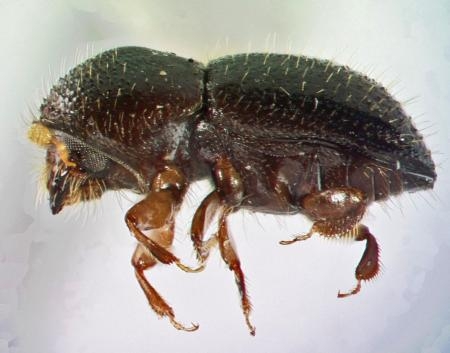
pshb insect
It's Dry Root Rot Time
Even though it's been a mild winter; other than fire, rain and some cool nights, we did have a few days of hot weather, which is just what sets off citrus dry root rot. It pops up after the first hot weather of the spring, and there it was driving down the road. There's nothing that can be done with this tree. Tree removal and replacement is the answer. Prevention is the solution. We know that Fusarium fungus is usually associated with the collapse, but wounding is the key. Mechanical injury from weed whips, discs, gophers, voles, rabbits. Wounding from salt damage might do it too.
Dry root rot, a disease caused by the soil fungus Fusarium solani, has a long history of hindering production of citrus in California. Fusarium solani is a weak pathogen that infects only when there is some kind of stress in citrus tree. However, presence in almost all citrus orchards everywhere in the world including California, enhance its quick exploitation of such stresses. Some of the factors that are possible stress include invasion by other pathogens, such as Phytophthora and Citrus Tristeza Virus (CTV). Other stresses are wounding by gophers/rodents or insects, girdling, asphyxiation especially drowning the tree with too much water, soil nutrient content and fertilization, irrigation, and other cultural practices in the orchard. The pathogen is an opportunist on citrus. With the stress, Fusarium solani begins infection by colonizing the cortical tissue of feeder roots, advances into the lower tap root and/or scaffold root, and move up through the bud union into the center of the trunk. Studies over the years have shown that many rootstocks are susceptible and old trees as well as young twigs are not spared of the disease.
http://ipm.ucanr.edu/PMG/r107100211.html
//ucanr.edu/blogs/blogcore/postdetail.cfm?postnum=17821
Photo: collapsed tree near and older one on the right, but also near a younger one that probably was a replacement for one that had collapsed several years prior
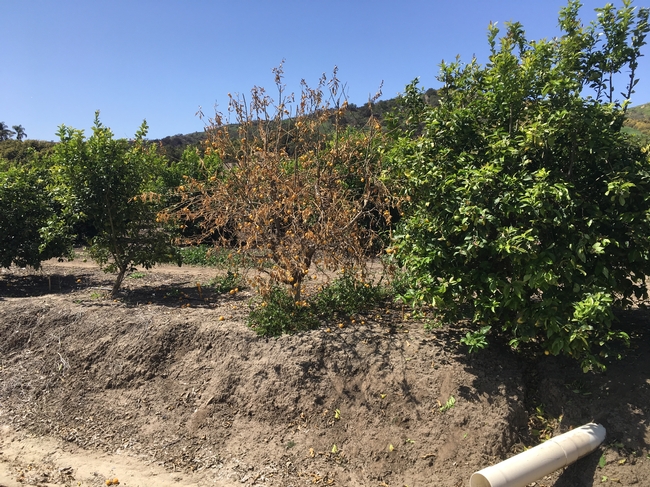
dry root rot time
Dogs to the Rescue
On a recent trip to Florida we saw a dog in action locating avocado trees that had been attacked by the Redbay ambrosia beetle which carries the fungus Raffalea lauricola which is a similar pest/disease complex that is found in California with the Polyphagous/Kuroshio Shot Hole Borer and Fusarium Euwallacea that leads to Fusasrium Wilt in avocado. The fungus gives off a certain odor that the dog is trained to smell and along with the human trainer goes around the orchard to identify infected trees. The trees can then be removed so that they don't act as a reservoir of infection that can be spread to other trees by the beetle. The dog seemed to work pretty fast. Depending on the acreage covered, the handler says they charge $150 per acre to find diseased trees. This can happen before more advanced symptoms show up that humans can see. This technology could be used in identifying other tree diseases, such as Huanglongbing, citrus canker and Phytophthora, along with others.
Dog has found a laurel wilt infected tree that will soon be removed. (Tim Spann).
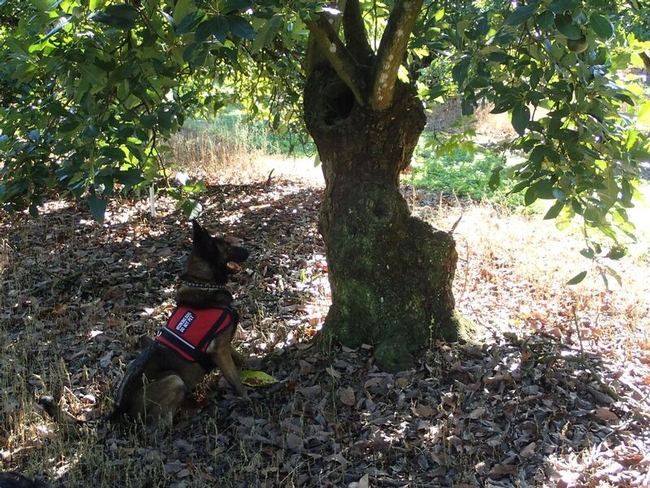
dog identifying lw tree
Florida Has a Probllem We May Be Getting
At a recent conference in Florida, University of Florida entomologist Daniel Carrillo reported some very disturbing news. There is a fungus/pest complex in Florida avocado and related native laurel species that is similar to a complex found in the California - Shot Hole Borer/Fusarium fungus complex. There it is called Laurel Wilt Disease and is a complex of the ambrosia beetle Xyleborus and the fungus Rafaelea lauricola. It is a fungus/insect complex that causes death in avocado and the relatives of avocado trees. The California complex can cause the death of many tree species, such as sycamore, coast live oak and willow, as well as the decline of avocado. The complex and disease are called Fusarium Dieback here, caused by Euwallacea ambrosia beetle and Fusarium fungus.
What Carrillo and other colleagues have found is that there are similar species to their introduced Rafaelea species of ambrosia beetle that are now attacking live avocado trees. These so-called cryptic species are members of a group of beetles that normally do not attack live trees. These beetles are typically some of the first group of decomposers that go after dead trees. These newly identified insects are morphologically very similar to the original beetle, but are native members of the Florida environment. They too are now attacking live trees. There are now ten potential species of ambrosia beetle that can introduce pathogenic fungi.
To exacerbate the situation, there are other fungi now that have been associated with these beetles that may be similarly as pathogenic as the original fungus. These fungi are genetically distinct from the species causing damage in California. However, this ability of different fungi to adapt to a new invasive beetle species and the ability of other beetle species to pick up the pathogenic fungal species is a scenario that might appear in California.
As the world becomes smaller and more living materials are moved around and they mix, this may be the new reality we are facing.
To read more about the Florida findings check out the article:
http://www.mdpi.com/2075-4450/7/4/55
http://ucanr.edu/sites/socaloakpests/Polyphagous_Shot_Hole_Borer/
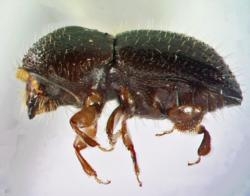
shot hole borer
How to Attract an Ambrosia Beetle that Attacks Avocado and Sycamore
There's a lot of work being done in Florida on a pest/disease complex like we have here with Shot Hole Borer and Fusarium fungus – Fusarium Dieback. This hits avocados and a lot of other native trees like sycamore, willow and coast live oak. Some of the success in Florida may be applicable and we are working with their researchers there to adapt some of the techniques here.
Redbay ambrosia beetle, Xyleborus glabratus, is a wood-boring pest that has now invaded nine states in the southeastern United States. The beetle's dominant fungal symbiont (Raffaelea lauricola) is phytopathogenic, inducing laurel wilt in trees within the family Lauraceae. Members of the genus Persea are particularly susceptible to the lethal disease, including native redbay (P. borbonia) and swampbay (P. palustris), as well as commercial avocado. Cubeb oil lures are the current standard for detection of X. glabratus, but recently eucalyptol and a 50% α-copaene oil have been identified as additional attractants. This study used a combination of choice bioassays, field cage release-and-recapture assays, and a 12-week field trial to compare efficacy of eucalyptol and copaene lures relative to commercial cubeb lures. In addition, gas chromatography (analyzer for volatiles) was used to quantify emissions from lures field-aged for 12 wk. In field cage assays, copaene lures recaptured a higher percentage of released beetles than cubeb lures. In the field test, cubeb lures captured fewer beetles than copaene lures, and lowest captures were obtained with eucalyptol lures. Both copaene and cubeb lures were effective in attracting X. glabratus for 12 weeks, but field life of eucalyptol lures was only 4 weeks, consistent with the quantification of lure emissions. Results suggest that the 50% α-copaene lure provides the best pest detection currently available for X. glabratus.
So why is this important? For one, it will serve as a tool for more effectively monitoring the presents of the beetle. But more importantly, it might be used as a lure to attract them away from trees. Fool them into going somewhere else, like to die.
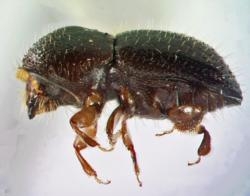
shot hole borer
